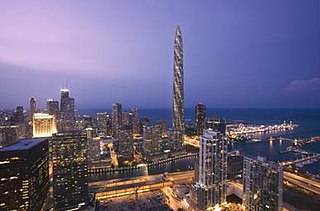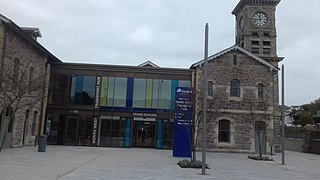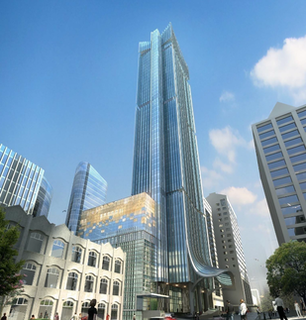
Aurora Tower is a skyscraper in Brisbane, Queensland, Australia. It is 207 metres tall and was the tallest building in Brisbane from 2006 until being surpassed by Soleil in 2011. Aurora has 69 storeys comprising four floors of 18 penthouses, 54 skyhomes and 408 apartments. It features a heated pool, entertainment area and cinema for residents. Aurora Tower opened to the public on 5 May 2006.

22 Bishopsgate, also known as Twentytwo, is a commercial skyscraper in London, England. Completed in 2020, it occupies a prominent site in Bishopsgate, in the City of London financial district, and stands at 278 m (912 ft) tall with 62 storeys. The project replaces an earlier plan for a 288 m (945 ft) tower named The Pinnacle, on which construction was started in 2008 but suspended in 2012 following the Great Recession, with only the concrete core of the first seven storeys. The structure was later subjected to a re-design, out of which it became known by its postal address, 22 Bishopsgate. It is the second tallest building in the United Kingdom.

Sprucefield is a major out-of-town retail park in the townland of Magherageery, County Down, Northern Ireland. It is on the southern edge of Lisburn; about one mile from Lisburn city centre, and ten miles (16 km) from central Belfast. Sprucefield is located beside the M1 motorway and the A1 road. It is split in two parts: the Sprucefield Centre and Sprucefield Park.
Belfast City Centre is the central business district of Belfast, Northern Ireland.

The Chicago Spire was a skyscraper project in Chicago that was partially built between 2007 and 2008 before being cancelled. Located at 400 N. Lake Shore Drive, it would have stood 2,000 feet (610 m) high with 150 floors and been the tallest building in the Western Hemisphere. When originally proposed as the Fordham Spire in July 2005, the design had 116 stories, included a hotel and condominiums, and was topped with a broadcast antenna mast. The building was designed and spearheaded by Spanish architect-engineer Santiago Calatrava and Chicago developer Christopher T. Carley of the Fordham Company. On March 16, 2006, the Chicago Plan Commission unanimously approved the initial design of the building. On November 4, 2016, a court ruling brought the original development plan and the extended litigation over the nine-year-old project to a close. Developer Garrett Kelleher signed over the property location to the project's biggest creditor, Related Midwest, who announced that they would not build the Spire and released their own site.

Nauru House is a landmark 52-storey building located in the Melbourne CBD, Victoria, Australia. The building was designed by architectural firm Perrott Lyon Timlock & Kesa and completed in 1977.

Londonderry railway station, known commonly as Waterside railway station, is a railway terminus in Derry, Northern Ireland, on the east bank of the River Foyle, operated by Northern Ireland Railways. It is on the Belfast–Derry railway line, terminating at Belfast Great Victoria Street.

Lisburn railway station serves the city of Lisburn in County Antrim, Northern Ireland.

The Obel Tower is a highrise building in Belfast, Northern Ireland, located on Donegall Quay on the River Lagan beside the Lagan Weir. Measuring 85 metres (279 ft) in height, the tower is the tallest storeyed building in Ireland, dominating the Belfast skyline. On completion it overtook the previous tallest building in Belfast and Northern Ireland, Windsor House.

The buildings and structures of Belfast, Northern Ireland comprise many styles of architecture ranging from Edwardian through to state-of-the-art modern buildings like the Waterfront Hall. The city's beautiful Edwardian buildings are notable for their display of a large number of sculptures. Many of Belfast's Victorian landmarks, including the main Lanyon Building at Queens University in 1849, were designed by Sir Charles Lanyon.

The NDG Auckland Centre is a proposed tower block consisting of a Ritz-Carlton hotel skyscraper in Auckland, New Zealand. If the tower is built, it would become the second tallest building in New Zealand at 209 metres (686 ft) and the second-tallest freestanding structure in Auckland after the Sky Tower.

Deansgate Square, formerly known as Owen Street, is a skyscraper cluster on the southern edge of Manchester City Centre, consisting of four towers, the tallest of which is 201 metres. The site is just south of Deansgate railway station and north of the Mancunian Way, bounded by Deansgate, Owen Street and the River Medlock.
The Tribeca Belfast development, formerly known as North East Quarter and previously Royal Exchange, is a planned £500 million development based in the north east of Belfast City Centre. It is a major mixed-use regeneration scheme, with a total area of 1.5 million sq ft (0.14 million m2) as of 2018. The development has generated controversy since its inception in 2003. Over the years, opposition has been levelled against its lack of care towards existing important built heritage, lack of integration with local small businesses and arts organisations and even its brand name, and much of its existence so far has been in the context of an arson attack on one of the existing buildings in 2004, while under the ownership of the developers.

Great Victoria Street is a railway station serving the city centre of Belfast, Northern Ireland. It is one of two major stations in the city, along with Lanyon Place, and is one of the four stations located in the city centre, the others being Lanyon Place, Botanic and City Hospital. It is situated near Great Victoria Street, one of Belfast's premier commercial zones, and Sandy Row. It is also in a more central position than Lanyon Place, with the Europa Hotel, Grand Opera House and The Crown Liquor Saloon all nearby.

Glider is a bus rapid transit system in Belfast, Northern Ireland, designed to improve the efficiency of mass transit in the city by connecting East and West Belfast and the Titanic Quarter via the city centre. The service is operated by Translink.
Belfast Grand Central station is a proposed integrated bus and railway station serving the city centre of Belfast, Northern Ireland. It is situated in a new neighbourhood known as Weaver's Cross. The interchange is currently under construction and will replace Great Victoria Street railway station and the Europa Buscentre. It is expected to open in 2025.












